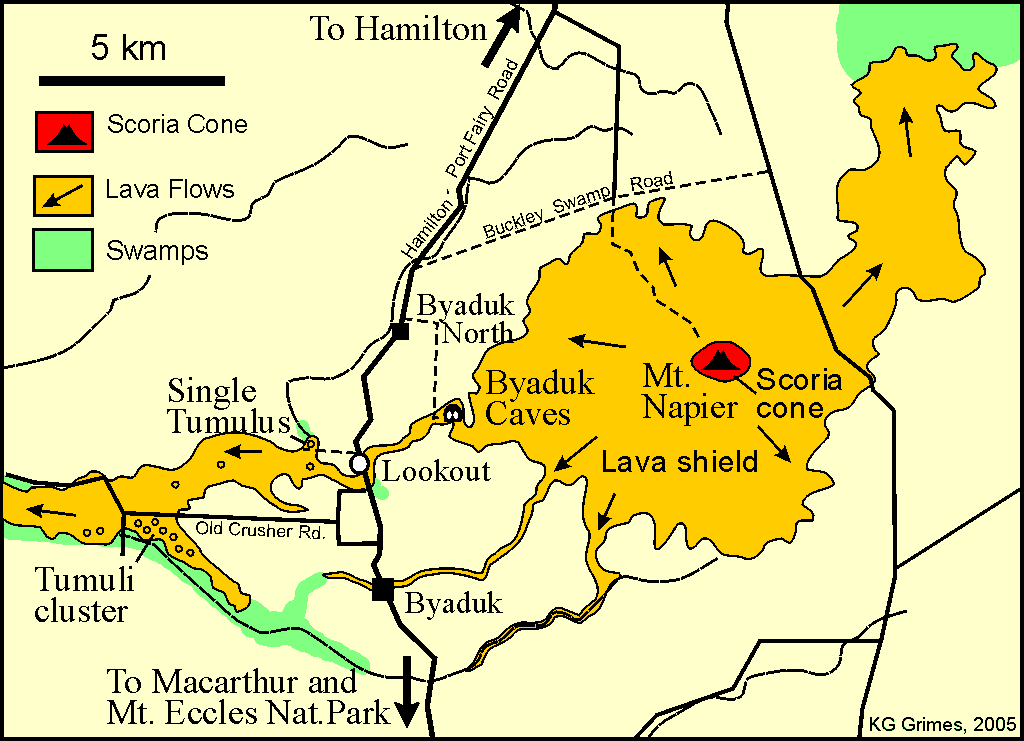Mount Napier on:
[Wikipedia]
[Google]
[Amazon]
 Mount Napier in
Mount Napier in
File:Napier1.JPG, Scoria from Mount Napier
File:Napier7.JPG, Close view of the volcanic rim
File:20090916_Harmans_Valley_looking_to_Mt_Napier_(2).JPG, Harmans Valley to Mount Napier
File:20090926_Volcanic_Blister_(Tumulus)_-_Byaduk_-_Victoria_-_Australia.JPG, Tumuli - lava blisters
Mt Napier State ParkByaduk Caves
Mountains of Victoria (Australia) Volcanoes of Victoria (Australia) Inactive volcanoes {{VictoriaAU-geo-stub
 Mount Napier in
Mount Napier in Victoria
Victoria most commonly refers to:
* Victoria (Australia), a state of the Commonwealth of Australia
* Victoria, British Columbia, provincial capital of British Columbia, Canada
* Victoria (mythology), Roman goddess of Victory
* Victoria, Seychelle ...
, Australia
Australia, officially the Commonwealth of Australia, is a Sovereign state, sovereign country comprising the mainland of the Australia (continent), Australian continent, the island of Tasmania, and numerous List of islands of Australia, sma ...
, is one of the youngest volcano
A volcano is a rupture in the crust of a planetary-mass object, such as Earth, that allows hot lava, volcanic ash, and gases to escape from a magma chamber below the surface.
On Earth, volcanoes are most often found where tectonic plates are ...
es in Australia. It erupted about 32,000 years ago. It was named by Major Thomas Mitchell after the three Napier brothers, who he had served alongside during the Peninsular War
The Peninsular War (1807–1814) was the military conflict fought in the Iberian Peninsula by Spain, Portugal, and the United Kingdom against the invading and occupying forces of the First French Empire during the Napoleonic Wars. In Spain ...
. Mitchell named it in August 1836, during his third expedition across south-eastern Australia. The local Aboriginal name for the mount is Tapoc. Mount Napier State Park is located 270 kilometres west of Melbourne
Melbourne ( ; Boonwurrung/Woiwurrung: ''Narrm'' or ''Naarm'') is the capital and most populous city of the Australian state of Victoria, and the second-most populous city in both Australia and Oceania. Its name generally refers to a met ...
and 17 km south of Hamilton Hamilton may refer to:
People
* Hamilton (name), a common British surname and occasional given name, usually of Scottish origin, including a list of persons with the surname
** The Duke of Hamilton, the premier peer of Scotland
** Lord Hamilt ...
.
Location and features
Mount Napier or Tapoc in the local Aboriginal language, has a compositelava shield
A shield volcano is a type of volcano named for its low profile, resembling a warrior's shield lying on the ground. It is formed by the eruption of highly fluid (low viscosity) lava, which travels farther and forms thinner flows than the mo ...
with a superimposed scoria cone
Scoria is a pyroclastic, highly vesicular, dark-colored volcanic rock that was ejected from a volcano as a molten blob and cooled in the air to form discrete grains or clasts.Neuendorf, K.K.E., J.P. Mehl, Jr., and J.A. Jackson, eds. (2005) ''G ...
. The cone rises above the surrounding plain
In geography, a plain is a flat expanse of land that generally does not change much in elevation, and is primarily treeless. Plains occur as lowlands along valleys or at the base of mountains, as coastal plains, and as plateaus or uplands ...
s to an elevation of , making it the highest point on the Western District Plains of Victoria. Mount Napier is part of the Newer Volcanics Province
The Newer Volcanics Province is a geological area which is a volcanic field, formed by the East Australia hotspot across south-eastern Australia. It covers an area of , with over 400 small shield volcanoes and volcanic vents. The area contain ...
, which is the youngest volcanic region in Australia. The Newer Volcanics Province covers an area of and contains over 400 vents.
The Mount Napier Lava Flow followed the Harman Valley west from the volcano, and then south towards nearby Mount Eccles
Budj Bim, also known as Mount Eccles, is a dormant volcano near Macarthur in southwestern Victoria, Australia. It lies within the geologically-defined area known as the Newer Volcanics Province, which is the youngest volcanic area in Austral ...
which is 25 km south-west of Mount Napier. Lava blisters or tumuli
A tumulus (plural tumuli) is a mound of earth and stones raised over a grave or graves. Tumuli are also known as barrows, burial mounds or ''kurgans'', and may be found throughout much of the world. A cairn, which is a mound of stones buil ...
occur along the flow - these are house-sized mounds of basalt rocks. The blisters are the best developed in Australia and uncommon in the rest of the world. They are formed by the pressure of liquid lava pushing up against the crust. Several caves and lava tubes can also be found at Byaduk.
The native vegetation of Mount Napier State Park, on the western side of the mountain, varies from grassy woodland to tall open forest dominated by Manna Gum ''Eucalyptus viminalis'', Blackwood ''Acacia melanoxylon'', Austral Bracken ''Pteridium esculentum'' and Common Tussock Grass ''Poa labillardieri''. This hosts a variety of native fauna, including birds, marsupials and mammals, including bats (Bird 1997).
Gallery
See also
* List of mountains in Victoria *List of volcanoes in Australia
This is a list of active, dormant and extinct volcanoes in Australia and its island territories. Note that the term volcano is used loosely as it can include groups of related volcanoes and vents that erupted at similar times with lava of rel ...
References
External links
Mt Napier State Park
Mountains of Victoria (Australia) Volcanoes of Victoria (Australia) Inactive volcanoes {{VictoriaAU-geo-stub